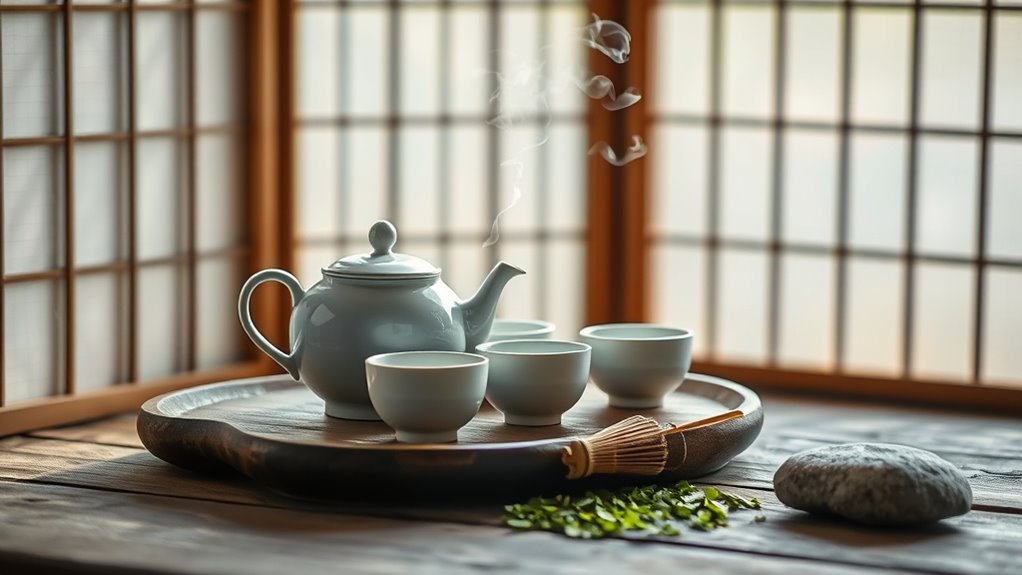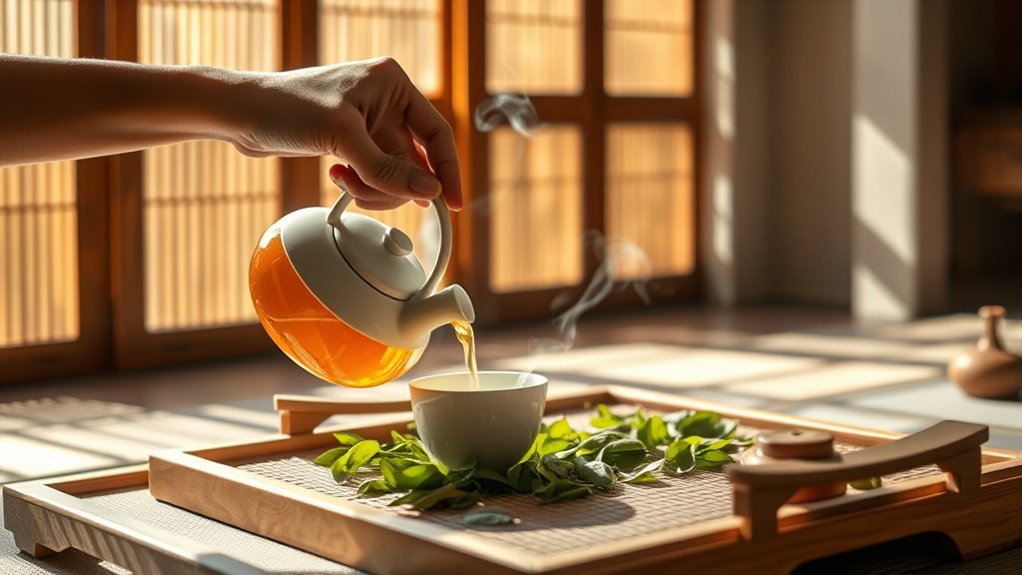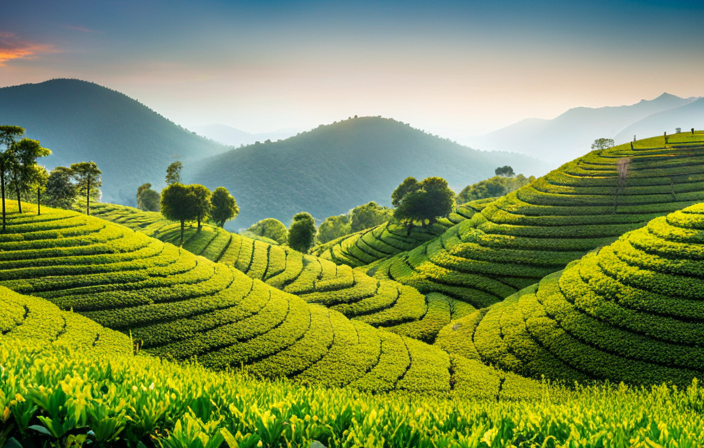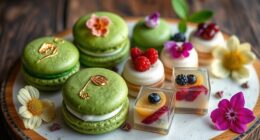Exploring “Cha‑Dao” reveals a way of life centered on harmony, mindfulness, and cultural tradition through tea. It’s about more than brewing; it’s a ritual that encourages patience, attention to detail, and respect for nature and others. This practice fosters community, reflection, and a deeper appreciation of simplicity and beauty. As you continue to understand its principles, you’ll discover how tea becomes a pathway to tranquility and connection in everyday living.
Key Takeaways
- Cha‑Dao, or “Tea Way,” emphasizes harmony, mindfulness, and simplicity in tea preparation and appreciation.
- It transforms tea drinking into a ritual that fosters reflection, serenity, and cultural connection.
- Core principles include respect, patience, and reverence for tradition, extending these values into daily life.
- Regional variations highlight unique cultural expressions, such as Zen-influenced humility in Japan and artistry in China.
- Engaging in Cha‑Dao promotes mutual respect, community, and a deeper understanding of cultural and philosophical ideals.

Cha‑Dao, often translated as the “Tea Way,” is more than just a method of preparing and drinking tea; it embodies a philosophy that emphasizes harmony, mindfulness, and appreciation of simplicity. When you engage in a tea ceremony, you’re not merely brewing tea; you’re participating in a ritual that connects you to centuries of tradition and cultural significance. This ceremony is a mindful act, inviting you to slow down, focus, and be present in the moment. It’s a deliberate process that transforms a simple beverage into an experience of serenity and reflection.
The tea ceremony is at the heart of Cha‑Dao’s cultural importance. It’s a symbol of harmony between nature, the tools used, and the people involved. As you perform the ritual, every movement is purposeful—pouring hot water, handling delicate utensils, and appreciating the aroma and taste of the tea. These actions foster a sense of respect and reverence, reinforcing the cultural values embedded in the practice. Through the ceremony, you learn to value patience and attention to detail, qualities that extend beyond the ritual itself into everyday life.
Additionally, understanding the cultural significance of the tea ceremony can deepen your appreciation for its role in fostering community and connection across different regions. The cultural significance of the tea ceremony varies across regions, yet the core principles remain consistent: it’s a reflection of harmony, respect, purity, and tranquility. In Japan, for example, the tea ceremony, or “chanoyu,” emphasizes grace, humility, and the beauty of imperfection, echoing Zen teachings. In China, the traditional process highlights the artistry of tea-making and the importance of social bonds. Participating in these ceremonies, you’re not just drinking tea—you’re engaging in a cultural dialogue that honors history, philosophy, and community. The act of sharing tea becomes an expression of hospitality and connection, fostering mutual respect and understanding.
Frequently Asked Questions
How Did the Concept of “Cha‑Dao” Originate Historically?
You might find that the concept of “cha‑dao” originated from China’s rich tea history and deep cultural roots. Historically, tea was more than a beverage; it symbolized harmony, respect, and spiritual cultivation. As tea culture evolved during the Tang and Song dynasties, the idea of tea as a way of life emerged, emphasizing mindfulness and balance. This tradition spread, shaping the philosophical and aesthetic principles behind “cha‑dao” today.
What Are the Core Principles Behind “Cha‑Dao”?
Did you know that over 80% of tea drinkers say mindfulness practice enhances their experience? The core principles of “cha‑dao” focus on aesthetic appreciation and harmony, encouraging you to savor each sip with presence and respect. It’s about embracing simplicity, patience, and balance — turning tea into a meditative ritual that cultivates inner peace and a deeper connection with nature.
How Does “Cha‑Dao” Influence Modern Lifestyle Choices?
You’re influenced by “cha‑dao” when you embrace mindful consumption, choosing quality over quantity and savoring each moment. It encourages cultural appreciation, helping you connect with traditions and values rooted in tea practices. This mindset promotes balance and intentionality in your lifestyle, inspiring you to slow down, reflect, and find harmony in everyday routines. By adopting “cha‑dao,” you create a more meaningful, culturally enriched approach to your modern life.
Can “Cha‑Dao” Be Practiced Outside of Tea Ceremonies?
Yes, you can practice “cha‑dao” outside of formal tea ceremonies. It’s about embracing tea mindfulness and incorporating daily rituals that promote calm, presence, and balance. You might start each day with a mindful tea pour or take a moment to appreciate a cup’s aroma and warmth. These small acts help you connect with “cha‑dao” principles, turning everyday moments into opportunities for reflection and harmony.
What Are Common Misconceptions About “Cha‑Dao”?
You might think “cha‑dao” is just about drinking tea, but it’s more than that—it’s a way of life. Many believe it’s a strict ritual or just about brewing techniques, but myth busting reveals it’s also about mindfulness and harmony. Cultural misinterpretations often oversimplify it, so don’t assume it’s only for tea ceremonies. Embrace the deeper meaning, and you’ll see “cha‑dao” is truly a path to inner peace.
Conclusion
As you embrace the philosophy of “Cha‑Dao,” you begin to see tea not just as a beverage, but as a path to harmony and mindfulness. Each sip invites you to slow down, reflect, and connect with life’s simple truths. Isn’t it beautiful how a humble cup can transform your perspective? So next time you brew tea, ask yourself: are you simply drinking, or are you stepping into a timeless journey of self-discovery?










